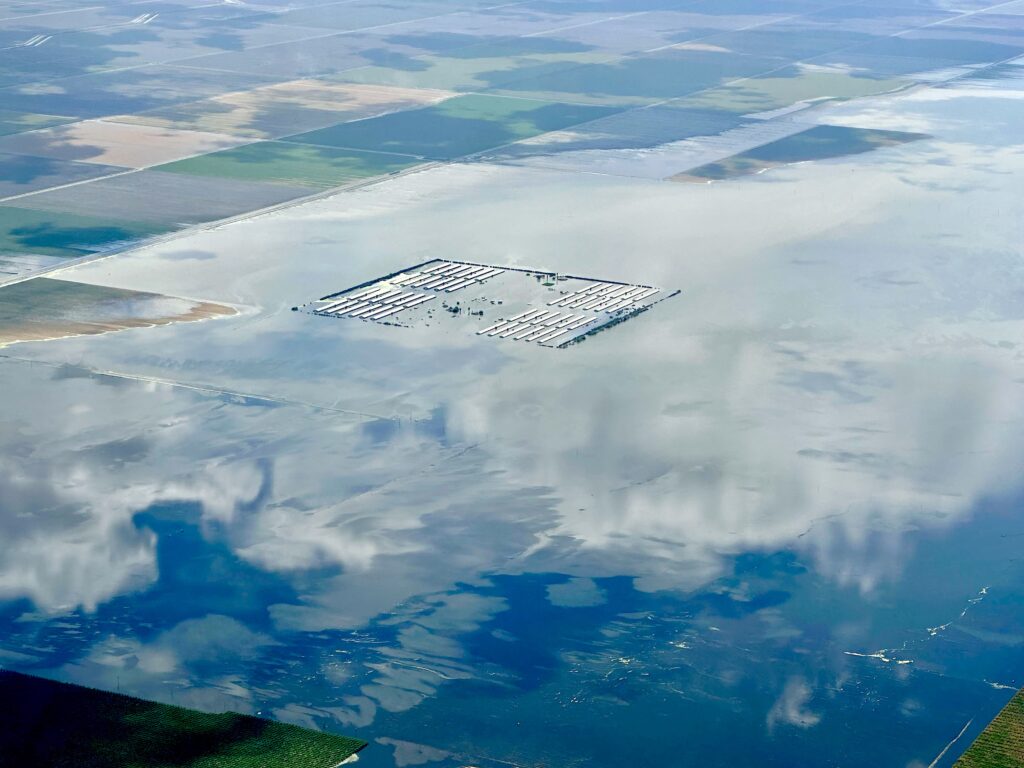Floodwater covering parts of the San Joaquin Valley is nasty – filled with animal and septic waste, road oil and other grunge from whatever it’s washed over.
Swimming in it is definitely not advised.
But over the long term, experts don’t think it will harm groundwater, which is where most valley residents get their drinking water.
“In the Tulare Lake basin, in particular, you have a lot of areas where the water table is pretty deep,” said Thomas Harter, a professor at UC Davis who specializes in groundwater resources in agricultural areas. “There’s going to be a lot of natural attenuation of whatever contaminants may be coming with the floodwaters if you’re not leaking directly into a borehole.”
The Tulare Lake basin, once home to the largest freshwater lake west of the Mississippi, was drained for agriculture more than 100 years ago. This year’s historic wet season has brought the lake back. Surging rivers are dumping water into the lakebed, flooding crops and dairies, and will continue to do so for months as the massive snowpack melts in the mountains.
The clean water coming downriver will push nitrates and salts below the root zone of plants, said Harter. And any bacterial or viral contamination will probably be diluted and weakened in deep groundwater areas, he said.
In the Tulare lakebed, the underground clay will help with further weaken contaminants, especially for microbial contamination, said Harter.
“I don’t think we’re talking about massive groundwater contamination from this flooding,” said Harter.
That said, there could be problems for certain wells if they aren’t properly insulated. Then, contaminated water could get into the well system, said Harter.
If a well does get inundated, the state Water Resources Control Board has a standard procedure to bring wells back to a usable condition.
First, the well owner will pump the contaminated water out, or “pump it to waste,” said Kurt Souza, assistant deputy director for the board’s Division of Drinking Water. That process might last for a couple hours. Then the state requires coliform samples for the water. That includes two E. Coli tests 24 hours apart.
If this happens for a small community system, the state will issue a “do not drink” order, said Souza. People will drink bottled water but can use the well water for other needs such as washing clothes and flushing toilets.
This standard procedure seems to work, he said. Souza heard about one well that was severely flooded recently. After flushing the well out, the water tested clean, he said.
But if the well is contaminated, there is a disinfection procedure, followed by flushing and more testing.
“The only thing that would be devastating for the well is if the motor burned up and you couldn’t clean it out,” said Souza.
Souza acknowledged that small communities at risk of flooding, such as Allensworth, could be in trouble if their systems flood.
If the well still has power, the state would provide emergency bottled water and the well would go through the standard flushing and testing procedure.
But if the well burns out or loses power, there aren’t many options, said Souza.
“All you can really do is truck in water if they lose their supplies,” said Souza.
When it comes to long term contamination, Souza said Department of Water Quality staff have echoed reassurances that dilution means there likely won’t be groundwater issues.
There has also been concern about flooding of human waste facilities in the Tulare lakebed. Tulare Lake Compost, for example, sits on more than 14,000 acres in the lakebed and processes human waste from Los Angeles.
“When the water gets there, they’ll put a levee around it,” said Doug Verboon, Kings County supervisor. “There’s no concern of contamination to any other ground that’s not been treated.”
Any water that does inundate the facility will remain on the already treated ground, said Verboon.
There shouldn’t be any long term contamination problems, said Verboon.
“The amount of water is so vast and so great. It is cleaning a lot of what people would be generally concerned with,” said Anja Raudabaugh, CEO of Western United Dairies. “There’s an old saying that hydrologists use and they say, ‘the solution to pollution is dilution.’”
The contamination may be severe for some time but as water continues to come down from the mountains, it will dilute the flood waters further, said Raudabaugh.
Still, Raudabaugh acknowledged that the flood water is dangerous and that people should keep out of it.
Share this:
- Click to share on Facebook (Opens in new window)
- Click to share on Twitter (Opens in new window)
- Click to share on LinkedIn (Opens in new window)
- Click to share on Reddit (Opens in new window)
- Click to share on Tumblr (Opens in new window)
- Click to share on Pinterest (Opens in new window)
- Click to share on Pocket (Opens in new window)
- Click to share on Telegram (Opens in new window)
- Click to share on WhatsApp (Opens in new window)
- Click to print (Opens in new window)








